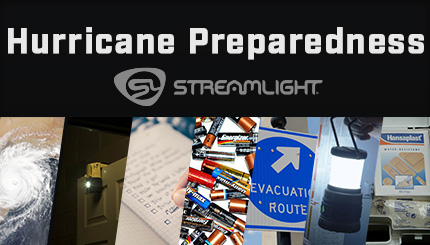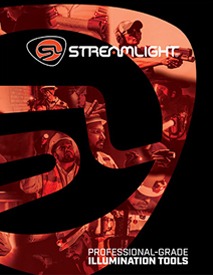Community Blogs Detail
Please wait while results are retrieved...
The first week of May is National Hurricane Preparedness Week. Streamlight knows how important it is to be prepared in case of an emergency, which is why we engineer our flashlights to be durable and have long run times. This year, during National Hurricane Preparedness Week, we want to remind our customers of the importance of being prepared for extreme weather events.
First, take some time to determine your hurricane risk based on your geographic location. As hurricane season approaches, different areas will be at higher risk over the course of the coming months. The National Weather Service provides hurricane resources to help individuals determine their risk. Once you know your personal hurricane risk, you can take the next steps to renew your insurance policies and develop a plan.
An essential part of every hurricane emergency plan is expecting the worst. While evacuating and riding out a storm safely is ideal, it’s important to be prepared in case you find yourself unable to evacuate during a hurricane. One way to prepare for this situation is to pack an emergency kit. While there are several pre-packed emergency kits available online, we’ve broken down a few of the major items to consider adding to your hurricane emergency kit.
Food & Water
Food and water are essential for survival. When preparing for a hurricane or packing an emergency kit, consider adding bottled water and non-perishable foods to your supplies. In the extreme case that you're caught in a storm for several days, you’ll want to be sure you have enough clean water and easy-to-prepare food to keep you in good health. This hurricane safety checklist from the Red Cross suggests having 3 days worth of food and water in your hurricane emergency kit.
First Aid Kit
If you or anyone else is injured during a hurricane, having a first aid kit on hand can make a big difference. Even if you already have a first aid kit in your home, we highly suggest having a separate one stored in your emergency hurricane kit. In the case of an extreme weather event, you might forget to grab your regular one and it may become unsafe to try and reach it later.
Flashlights
When a hurricane hits, power is often one of the first resources to go out. When the lights fail, you’ll need a flashlight to help light your way. At Streamlight, we recommend having a few different types of lights in the house to help prepare for these uncertain situations.
Power Failure Light
A power failure light is exactly what it sounds like: a light that turns on in the case of a power outage. Streamlight’s E-Flood® LiteBox® Power Failure System is a lantern that serves this purpose well. Mount the charging station to a wall or let the light sit tabletop, and when the power goes out, you’ll automatically have light. This works well as a stationary area light, or it can be removed from the dock and carried from room to room.
Handheld Flashlight
A handheld flashlight is a perfect light to throw right into your emergency kit. If you’re going to store it away for months at a time without checking in on it, we recommend opting for a non-rechargeable light so you can easily swap the batteries and know you’ll have light.
Our handheld flashlight picks are the Dualie® 2AA and the ProTac® 1L-1AA. Both lights run on AA batteries, have bright light output, and can run from 14-16 hours straight before the batteries need to be changed. If you have more than one person in the house, consider picking up two or more handheld flashlights for your kit.
Lantern
Lanterns that have 360º light output are perfect for illuminating a small space or room. When the lights go out during any extreme weather, it can be comforting to have a lantern that lights up an entire space. These lights are portable and our Siege® lanterns come with D-rings on the top and bottom and an ergonomic handle, making them easy to hang or carry.
Whatever types of flashlights you choose to have on hand, make sure you’ve got them properly stored and charged so they’ll be ready in case of an emergency.
Batteries & Power Banks
Whether you need them to power or charge flashlights, a radio, or your cell phone, you can never have too many batteries and power banks in your emergency kit. In the event of a hurricane, if you lose power for several days, you’ll need some way to power up your different devices. This is another case where you may have batteries or portable chargers already in the house, but it’s important to dedicate some to your emergency kit so you’ll have them in your time of need.
Emergency Blanket
Losing power could mean losing heat. Depending on the time of year and how bad the weather gets, one thing you may find yourself in need of during a hurricane is an emergency blanket. Your emergency blankets could just be spare throw blankets around the house, or you might consider investing in insulated blankets that hold in heat and are waterproof.
At Streamlight, we value safety and know that one of the best ways to stay safe in the event of a hurricane is to be prepared. During this year's National Hurricane Preparedness Week, we urge you to take the steps to make a hurricane emergency plan and be prepared!
PHONE
1-800-523-74881-610-631-0600
FAX
1-800-220-70071-610-631-0712


